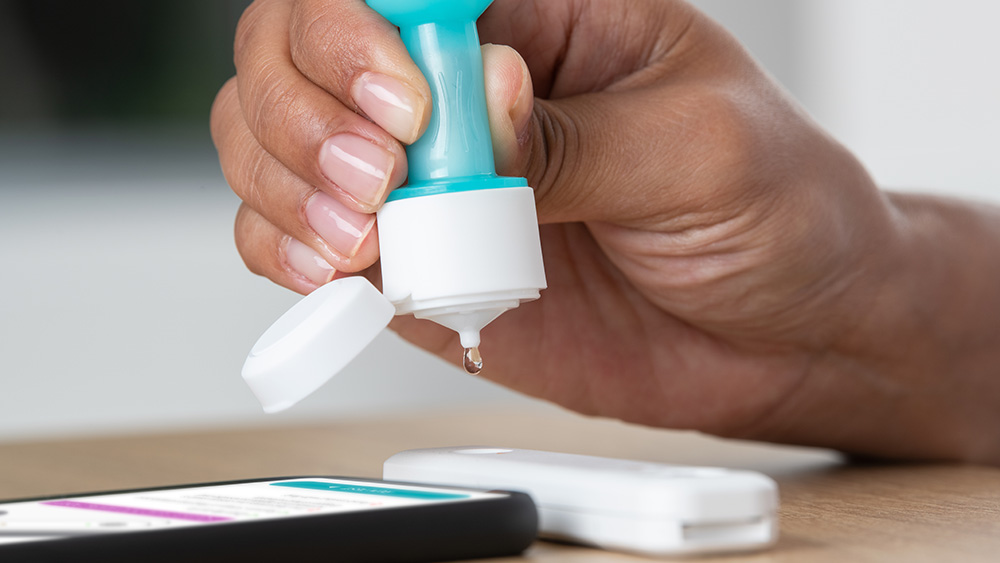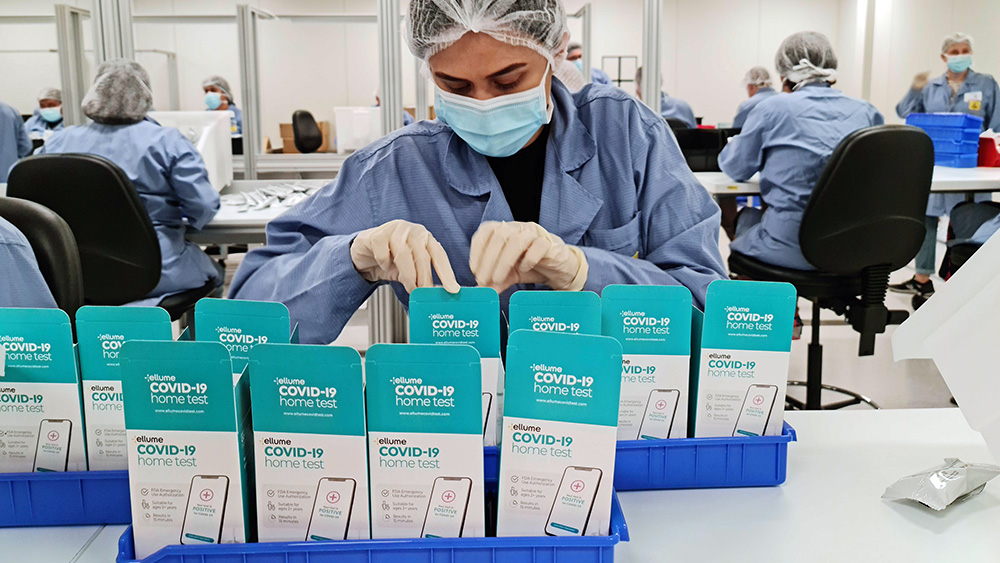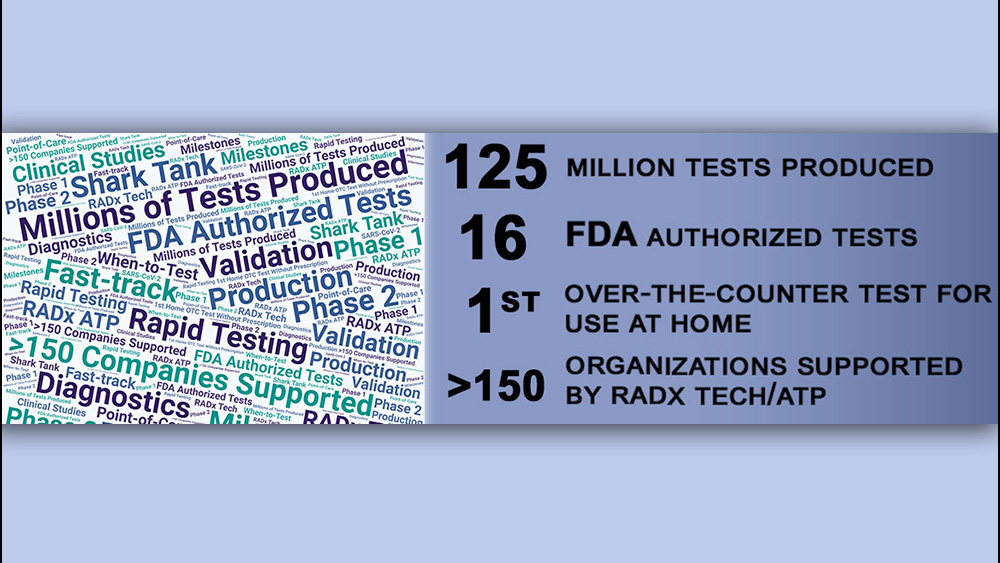Article Highlights
-
NIH supported the development of the first at-home COVID-19 test available without a prescription.
-
Home test kits are 96% accurate for people with or without symptoms.
-
Learn how the COVID-19 at-home test works by reading this quick start guide. (PDF | 692KB)
When SARS-CoV-2, the virus that causes COVID-19 infections, first emerged, there was no test to detect it. By early 2021, the U.S. Food and Drug Administration (FDA) had authorized nearly 300 tests, and U.S. labs were running 1.8 million tests per day. Still, long lines and finding time to get tested are a barrier for many. Now, thanks in large part to the NIH Rapid Acceleration of Diagnostics (RADxSM) initiative, you can take a COVID-19 test at home, with results on your smartphone in as little as 15 minutes.
The RADx initiative includes different programs to support innovation in testing and increase availability of COVID-19 tests. Institutions and industries supported under the RADx Tech program developed tests that can be done in homes, drugstores, and mobile clinics. The RADx Advanced Technology Platforms (ATP) program first identifies existing test systems or ones that are in advanced stages of development. ATP then helps expand, improve, and speed up production to make many tests available in a short time.
In December 2020, the FDA issued an emergency use authorization (EUA) for the first over-the-counter (OTC) at-home rapid, antigen test for COVID-19. The test is made by Ellume, an Australian company specializing in digital diagnostic tests, many of which don’t require professional laboratory services. The company achieved this by partnering with RADx Tech/ATP.
Sean Parsons, MBBs, BSc, CEO and founder of Ellume, and Bruce J. Tromberg, Ph.D., director of the National Institute of Biomedical Imaging and Bioengineering (NIBIB) and the leader of the RADx Tech and ATP programs, spoke with us about the RADx initiative, COVID-19 tests, and the project that led to the EUA for the Ellume home test.
As of May 2021, Ellume home test kits are available for sale without a prescription at many U.S. retail pharmacies.

The user begins by downloading an app on their smartphone to guide them step-by-step through the test procedure. After swabbing their nose, the user inserts the swab into a dispenser containing a special fluid. The user squeezes a few drops into a port on the analyzer and places it near their smartphone. Fifteen minutes later, the result appears on the phone. Photo courtesy of Ellume.

The user begins by downloading an app on their smartphone to guide them step-by-step through the test procedure. After swabbing their nose, the user inserts the swab into a dispenser containing a special fluid. The user squeezes a few drops into a port on the analyzer and places it near their smartphone. Fifteen minutes later, the result appears on the phone. Photo courtesy of Ellume.
How does the Ellume COVID-19 home test work? What do users think about the test?
PARSONS: The Ellume test is the first FDA-authorized COVID-19 test that does not need a prescription and can be done completely at home. Results appear on the user’s smartphone in 15 minutes. Users may share results with their doctor, employer, public health department, or school.
We designed the test kits to be easy to use, with little chance for human error. Remember that people may be sick and not at their best when they run the test. Studies showed that 96% of users find home tests easy to use. Ninety-five percent were confident about using the test kits at home, and more than 99% read their results correctly.
How well does the Ellume home test work?
PARSONS: We tested the home kits with 198 people in five states. Some had symptoms, but others were symptom free. We learned that our COVID-19 home test kits are 96% accurate and sensitive enough to detect 95% of infections. The test works well for people with or without symptoms.
TROMBERG: The Ellume home test is excellent in terms of performance. The clinical trials showed that it is very accurate and able to detect low levels of SARS-CoV-2. Many other COVID-19 tests aren’t sensitive enough to detect the low levels of virus in people who don’t have symptoms.
We’ll learn much more about how well the kit performs when millions of tests are in use. No test is perfect, however. This type of test should be repeated several times a week as we reopen businesses and schools.
How did the partnership between Ellume and RADx Tech lead to such rapid progress?
PARSONS: Ellume has been developing point-of-care (POC) tests for healthcare professionals and at-home tests for consumers for more than a decade. We had developed similar tests for other infectious diseases. That experience meant we were ready to meet the challenge of developing a COVID-19 home test.
I founded Ellume with the idea of developing digital diagnostic tools that would not only help reduce the spread of disease but link patients to optimal treatment. We made a major scientific breakthrough, allowing us to perfect a simple, effective, and affordable core technology. We applied the core technology to develop tests for several infectious diseases, including influenza A and B, tuberculosis, and now, with RADx Tech/ATP support, COVID-19.
The support from the NIH RADx Tech/ATP programs was critical to developing an at-home test in record time and bringing the Ellume home test to the United States. We received initial funding to develop the test and collect data to support the application for an EUA. Additional funds from NIH helped us to finish the application that secured the EUA, and boost production of the test kits.
TROMBERG: This project is a great example of how a technology that hasn’t quite made it to the marketplace can succeed with government support. The funds awarded to Ellume reduced their business risk and offset the costs of evaluating the test’s accuracy and usability.

Workers assemble home test kits at Ellume’s facility in Australia. Ellume will produce tests for the U.S. market at a new plant in Maryland. Photo courtesy of Ellume.

Workers assemble home test kits at Ellume’s facility in Australia. Ellume will produce tests for the U.S. market at a new plant in Maryland. Photo courtesy of Ellume.
Now that FDA has authorized the home test, what’s next for Ellume and RADx Tech?
PARSONS: As Ellume expands its operations, the home test kits will become available to buy in stores and online in the United States without a prescription. We’ve increased manufacturing capacity to 100,000 tests per day in Australia to help meet U.S. demand. Under a $232 million contract with the Department of Defense and the Department of Health and Human Services, we are setting up a U.S. facility to increase domestic production capacity by at least a half-million tests per day.
We will continue our work with the U.S. government to respond to COVID-19 and better prepare for future pandemics.
TROMBERG: Once Ellume’s new U.S. plant is operational, it will more than double the company’s manufacturing capability in the United States.
Because we want tests to be available for everyone, the cost of home test kits is important. The price [as of May 2021] is just under $40—much less expensive than many other tests for COVID-19.
RADx Tech/ATP continues to support a variety of new technologies that will give us more choices and help further reduce the price of tests. For example, we’ve also supported the Quidel QuickVue At-Home COVID-19 Test, which received an EUA in March 2021 for over-the-counter screening when repeated several times over two or three days. The test was also used in a separate NIBIB study to evaluate a smartphone app that gives instructions to users and helps them interpret the results of their COVID-19 at home test.
It’s exciting that Ellume has been able to unite several cutting-edge technological advances to create a simple home test. This success demonstrates the power of innovation and the role of RADx Tech/ATP in responding to the pandemic and in helping prepare for future disease outbreaks.

Find Similar RADx Projects
The NIH RADx Initiative and RADx ATP platforms aim to speed up the pace of developing and commercializing tests to diagnose COVID-19.
References
Moser, M. (February 25, 2021). U.S. Congress Launches O&P Caucus. Optics and Photonics News. Accessed March 1, 2021, from https://www.osa-opn.org/home/newsroom/2021/february/u_s_congress_launches_o_p_caucus/
Moser, W. (February 3, 2021). Fewer Americans Are Getting COVID-19 Tests: Our Best Coronavirus Tracking Tool Is Still Underused. The Atlantic. Accessed March 9, 2021, from https://www.theatlantic.com/health/archive/2021/02/fewer-americans-getting-covid-tests/617914/
 An official website of the United States government
An official website of the United States government


